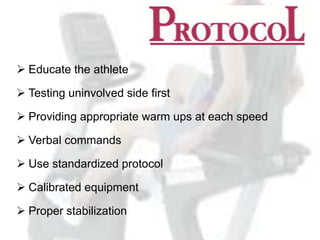Isokenetic testing in sports
- 1. Isokinetic testing in Sports Dr. Rajal Sukhiyaji
- 2. Introduction Concept of isokinetics What is isokinetics? OKC and CKC Purposes of isokinetic testing Protocol of isokinetic testing Isokinetic data and analysis Advantages Limitation Contraindication
- 3. “James Perrine” first introduced the concept of Isokinetic exercise to the physical therapy profession in the late 1960’s. Isokinetic means constant speed: “Iso” means constant and “kinetic” means movement.
- 4. Concept of isokinetics Traditional weight lifting exercises - variable speeds at a fixed resistance or weight. Isokinetic exercises - at a dynamic preset fixed speed with resistance that is accommodating throughout the range of motion.
- 5. What is Isokinetics?? Fixed velocity – Ranging from 1 degree per second to approximately 1000 degree per second. Accommodating resistance Isokinetic dynamometers - used are Biodex, Humac, Cybex, Kin-Com, Lido
- 6. OKC & CKC OKC - Open kinetic chain exercise in which the distal component of the limb is not fixed or weight bearing but free in space. CKC - Closed kinetic chain exercise in which distal fixed end of the limb may be either stationary or moveable
- 7. Rationale for incorporating OKC into assessment and rehabilitation Isolated testing of specific muscle group Muscle groups away from specific site of injury must be assessed CKC – not demonstrate true weakness Provide clinical control Normalize the motor control pattern Efficacy of rehabilitation
- 8. Objectively assess muscular performance. The Isokinetic device is attached to a computer, that assesses the torque output of the muscles being testing.
- 9. Isokinetic testing allows for a variety of testing protocols ranging from strength, strength ratios between two muscle groups, power, and endurance. Primary recommendation – perform velocity spectrum testing
- 10. To obtain objective records To screen athletes To establish a database To quantify objective information To obtain objective serial reassessment To develop normative data To correlate isokinetic torque curves with pathologic condition To use the shape of the curve to individualize the rehabilitation program.
- 11. Educate the athlete Testing uninvolved side first Providing appropriate warm ups at each speed Verbal commands Use standardized protocol Calibrated equipment Proper stabilization
- 12. Isokinetic data and analysis Peak torque Angular position Acceleration Deceleration Load rang Torque – velocity relationship Average power Shape of the torque curves
- 13. Criteria for interpreting isokinetic tests results Bilateral comparison Unilateral ratios Torque to body weight relationship Comparison to normative data
- 14. Efficiency Safety Accommodating resistance Decreased joint compressive forces at higher speeds Physiologic overflow through the velocity spectrum Velocity spectrum training Minimal postexercise soreness with concentric isokinetic contraction Computer feedback provided
- 15. Large and expensive Set up time and assistance required Isolated joint/muscle testing Non functional pattern of movement Increased compressive forces at slower speeds
- 16. Contraindication Soft tissue healing constraints Pain Limited ROM Effusion Joint instability Acute strains and sprains
- 17. Physical rehabilitation of the injured athlete, third edition, James R. Andrews, M.D., et al. Isokinetic Dynamometry Applications and Limitations, V. Baltzopoulos and D.A . Brodie Isokinetics in Human Performance, By Lee E. Brown Isokinetic Exercise, By Robert Donatelli, PhD, PT, Sportsmd health and performance

















